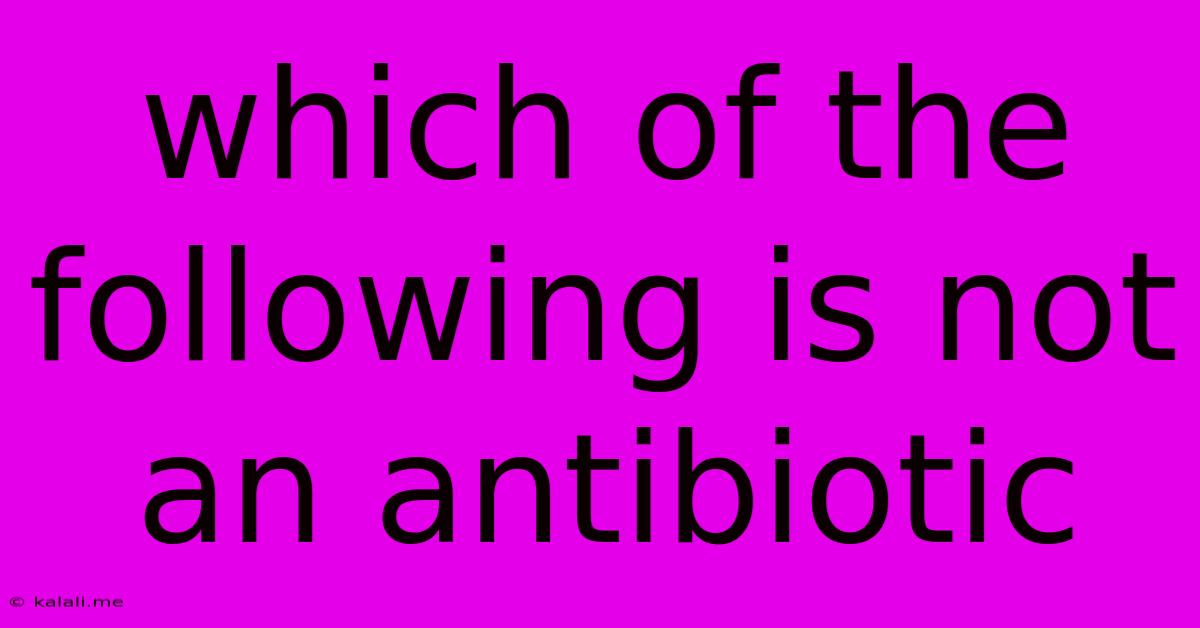Which Of The Following Is Not An Antibiotic
Kalali
Jun 13, 2025 · 2 min read

Table of Contents
Which of the Following is Not an Antibiotic? Understanding Antibiotic Classes and Alternatives
Antibiotics are powerful medications used to fight bacterial infections. They work by targeting specific processes within bacterial cells, ultimately killing the bacteria or preventing their growth. However, not all medications used to treat infections are antibiotics. This article will clarify what constitutes an antibiotic and explore examples of medications that are not antibiotics. Understanding this distinction is crucial for effective treatment and preventing the rise of antibiotic resistance.
What Defines an Antibiotic?
The key characteristic of an antibiotic is its ability to selectively inhibit the growth or kill bacteria. This selective toxicity means the antibiotic harms bacterial cells without causing significant harm to human cells. They achieve this through various mechanisms, targeting processes like bacterial cell wall synthesis, protein synthesis, DNA replication, or folic acid metabolism.
Examples of Antibiotics:
Several classes of antibiotics exist, each with different mechanisms of action and targets. Some common examples include:
- Penicillins: A widely used class targeting bacterial cell wall synthesis.
- Cephalosporins: Another class that also targets cell wall synthesis, often used when penicillin allergies are present.
- Tetracyclines: These inhibit protein synthesis in bacteria.
- Macrolides (e.g., erythromycin): Also inhibit bacterial protein synthesis.
- Aminoglycosides (e.g., gentamicin): Interfere with bacterial protein synthesis.
- Fluoroquinolones (e.g., ciprofloxacin): Target bacterial DNA replication.
Which of the Following is NOT an Antibiotic?
Now, let's address the core question. To answer definitively, we need a list of options. However, we can discuss common examples of medications that are not antibiotics:
-
Antivirals: These medications target viruses, not bacteria. Examples include acyclovir (for herpes) and oseltamivir (for influenza). Viruses are fundamentally different from bacteria, requiring different treatment strategies. Antibiotics are completely ineffective against viral infections.
-
Antifungals: These are used to treat fungal infections. Examples include fluconazole and amphotericin B. Fungi, like viruses, are distinct from bacteria.
-
Antiparasitics: These medications combat parasitic infections. Examples include metronidazole (for some parasitic infections) and ivermectin (for certain parasitic worms). Parasites also have different cellular mechanisms compared to bacteria, rendering antibiotics ineffective.
-
Pain Relievers/Analgesics (e.g., ibuprofen, acetaminophen): These medications reduce pain and fever but do not have any antibacterial action. They treat symptoms rather than the underlying infection.
-
Anti-inflammatory Drugs (e.g., corticosteroids): While these can help manage the inflammation associated with some infections, they are not antibiotics and do not kill bacteria.
Understanding the Importance of Correct Medication
Choosing the right medication is paramount for effective treatment and preventing the development of resistance. Using antibiotics inappropriately—for viral infections, for example—contributes to the growing problem of antibiotic-resistant bacteria. Always consult a healthcare professional to diagnose your infection and determine the appropriate treatment. They can accurately identify the type of pathogen causing your illness and prescribe the correct medication, be it an antibiotic, antiviral, antifungal, or other type of medicine. Self-medicating with antibiotics is dangerous and can have serious consequences.
Latest Posts
Latest Posts
-
Which Of The Following Is An Example Of Symbiosis
Jun 14, 2025
-
Select The Word That Means Present From Birth
Jun 14, 2025
-
Which Of The Following Statements Is Not True About Friction
Jun 14, 2025
-
Middle Tennessee State University Act Requirements
Jun 14, 2025
-
How Long Is The Penalty Spot From The Goal
Jun 14, 2025
Related Post
Thank you for visiting our website which covers about Which Of The Following Is Not An Antibiotic . We hope the information provided has been useful to you. Feel free to contact us if you have any questions or need further assistance. See you next time and don't miss to bookmark.